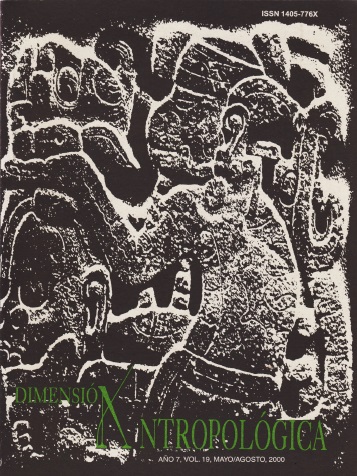Publicado 2000-08-31
Palabras clave
- Mesoamérica,
- problemas conceptuales,
- comercio,
- composición étnica
Cómo citar
Mesomérica aun sin Mesoamérica. (2000). Dimensión Antropológica, 19, 153-166. https://revistas.inah.gob.mx/index.php/dimension/article/view/8340
Resumen
La alta civilización en el terreno mundial sólo ha surgido en unos contados lugares. Nos referimos a regiones donde por primera vez apareció la agricultura como en Mesopotamia, los valles del río Nilo en Egipto, del río Índico en Pakistán y la India, y del río Huangho con las costas sur y oriental de China, así también como Tailandia, los Andes Centrales y México. El proceso ha sido interpretado como un paso del sedentarismo neolítico, implícito en la explotación intensiva de plantas y animales domésticos, al desarrollo del urbanismo manifestado en ciudades.
Descargas
Los datos de descarga todavía no están disponibles.
Referencias
- Childe, V. Gordon, Man Makes Himself, Londres, Watts, 1936.
- ____________, The Prehistory of European Society, Pelican Books, Harmondsworth, 1956.
- Kirchhoff, Paul, “Mesoamérica, sus límites geográficos, composición étnica y caracteres y culturales”, Suplemento de la Revista Tlatoani, México, ENAH, Sociedad de Alumnos, 1963, 1967.
- Kroeber, Alfred L., Cultural and Natural Areas of Native North America, núm. 38, Berkeley, The University of California Publications in American Archaelogy and Ethnology, 1939.
- MacNeish, Richard S., The Science of Archaeology?, North Scituate, Duxbury Press, 1978.
- Meggers, Betty J., “Archaeological Evidence for the Impact of Mega-Niño Events on Amazonia During the Past Two Millennia”, en Climatic Change, vol. 28, 1994, pp. 3121-3338.
- ____________, “Biogeographical Approaches to Reconstructing the Prehistory of Amazonia”, en Biogeographica, 70 (3), 1994, pp. 97-110.
- Wilkerson, S. Jeffrey K., Ethnogensis of the Huastecs and Totanacs, Early Cultures of North-Central Veracruz at Santa Luisa, Mexico, Michigan, The University Microfilms, Ann Arbor, 1972.
- ____________, “Cultural Sub-areas of Eastern Mesoamérica”, en Primera Mesa Redonda de Palenque, Pebble Beach, R.L. Stevenson School, 1974, pp. 89-102.
- ____________, “Pre-Agricultural Village Life: The Late Preceramic Period in Veracruz", en Contributions of the University of California Archaeological Research Facility, núm. 27, The University of California, Berkeley, 1975, pp.11-122.
- ____________, “Eastern Mesoamerica from Prehistoric to Colonial Times: A Model of Cultural Continuance”, en Actes du XLII Congres International des Americanistes, vol. VIII, París, 1979.
- ____________, Cultural Traditions and Caribbean Identity: The Question of Patrimony, Gainesville, Center for Latin American Studies, The University of Florida, 1980.
- ____________, “Man s Eigthy Centuries in Veracruz”, en National Geographic Magazine, núm. 158 (2), 1980, pp. 202-231.
- ___,”The Northern Olmec and Pre-Olmec Frontier on the Gulf Coast”, en M.D. Coe y D. Grove (eds.), The Olmec and Their Neighbors, Washington, D.C., Dumbarton Oaks., 1981, pp. 181-194.
- ____________, “So Green and Like a Garden: Intensive Agriculture in Anciente Veracruz”, en Darch, J.P. (ed.), Drained Field Agriculture in Central and South America, Oxford, BAR International Series 189,1983, pp. 55-90.
- ____________, Sacrifice at Dusty Court: Evolution and Diffusion of the Ritual Ball Game of Northeastern Mesoamerica, Tampa, Institute for Cultural Ecology of the Tropics, 1984.
- ____________, El Tajín, una guía para visitantes, Jalapa, 1987.
- ____________, “Perspectivas sobre la prehistoria de Veracruz y la costa del Golfo de México”, en Alba González Jácome (ed.), Orígenes del hombre americano (Seminario), México, SEP, 1988, pp. 209-230.
- ____________, “And they were sacrificed: the ritual ball game of northeastern Mesoamerica through time and space”, en V. L. Scarborough and T D. Wilcox, eds., The Mesoamerican Ballgame, Estados Unidos de América, The University of Arizona Press, 1991.
- ____________, “Escalante s Entrada. The Lost Aztec Garrison of the Mar del Norte in New Spain”, en National Geographic Research and Exploration, núm. 9 (1), Washington, D. C., National Geographic Society, 1993a, pp. 12-31.
- ____________, “Intellectual Property: The Need for a Shared International Perspective”, en National Geographic Research and Exploration, núm. 9 (1), Washinton, D. C., National Geographic Society, 1993b, pp. 3-4.
- ____________, “The Garden City of El Pital: The Genesis of Classic Civilization in Eastern Mesoamerica”, en National Geographic Research and Exploration, Washington, D.C., núm. 10 (1), 1994a, pp. 56-71.
- ____________, “Nahuatl Presence on the Mesoamerican Gulf Coast”, en E. Quiñones-Keber (ed.), Chipping away on Earth, Estados Unidos de América, Labyrinthos Press, 1994b, pp. 177-186.
- ____________, “Grosswild, fruhe Menschen uns erste Dorfer im Tiefand Ostmexikos”, en Prakolumbische Kulturen am Golf von Mexiko, Zurich, Museum Tietberg Zurich, 1997a, pp. 19-24.
- ____________, “In Booten Uber das Meer-die Herkunft der Nahuas”, en Prakolumbische Kulturen am Golf von Mexiko, Zurich, Museum Tietberg Zurich, 1997b, pp. 55-60.
- ____________, “El Tajin und der Hohepunkt der Klassischen Veracruz-Kultur”, en Prakolumbische Kulturen am Golf von Mexiko, Zurich, Museum Tietberg Zurich, 1997c, pp. 61-76.
- ____________, “Die Huaxteca: Ein mittelarnrikanisches Grenzland”, en Prakolumbische Kulturen am Golf von Mexiko, Zurich, Museum Tietberg Zurich, 1997d, pp. 175-186.
- Wissler, Clark, The American Indian, Nueva York, Oxford University Press, 1950.

